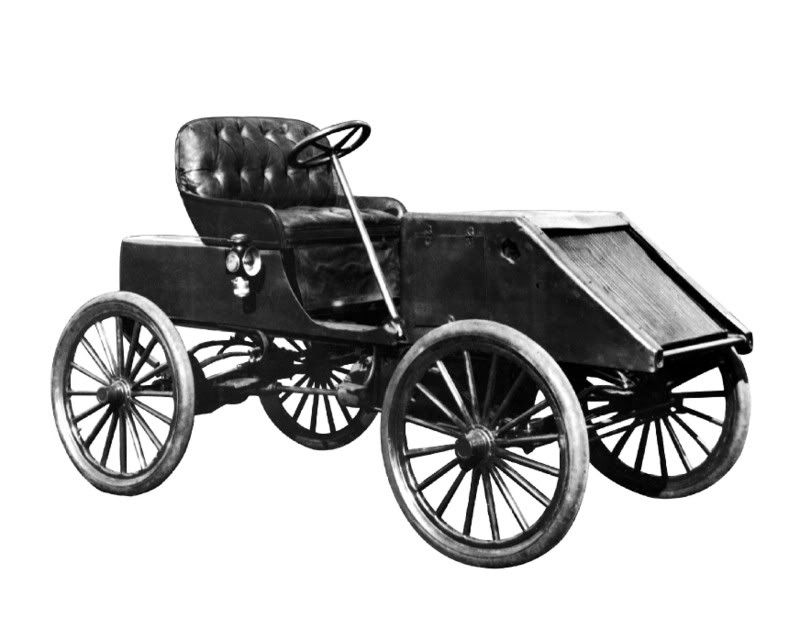
On this day, May 19th 1903
Clarence Spicer received a patent for a "Casing for Universal Joints"; first practical universal joint to power automobile (vs. chain-and-sprocket drives
Pictured: First car utilizing Spicer's universal joint, built at Cornell in 1903. Spicer had attended Alfred Academy where he studied physiology, then applied human joint structure to the auto.
May 19th 1903
David Dunbar Buick, former plumbing inventor and manufacturer, incorporated Buick Motor Co. (formed in 1902) in Detroit, Michigan.
May19th 1928
Colin Chapman, the founder of Lotus Cars was born in the suburb of London.
May19th 1991
Willy T. Ribbs became the first African-American driver to qualify for the Indy 500.
May19th 2007
Los Angeles, California, is the first stop on a cross-country road show launched on this day in 2007 by Smart USA to promote the attractions of its "ForTwo" microcar, which it had scheduled for release in the United States in 2008.
In the early 1990s, Nicholas Hayek of Swatch, the company famous for its wide range of colorful and trendy plastic watches, went to German automaker Mercedes-Benz with his idea for an "ultra-urban" car. The result of their joint venture was the diminutive Smart (an acronym for Swatch Mercedes ART) ForTwo, which debuted at the Frankfurt Motor Show in 1997 and went on sale in nine European countries over the next year. Measuring just over eight feet from bumper to bumper, the original ForTwo was marketed as a safe, fuel-efficient car that could be maneuvered easily through narrow, crowded city streets. Despite its popularity among urban Europeans, Smart posted significant losses, and Swatch soon pulled out of the joint venture.
Undaunted, Mercedes maker DaimlerChrysler (now Daimler AG) launched the Smart ForTwo in Canada in 2004 as an initial foray into the North American market. In June 2006, DaimlerChrysler chairman Dieter Zetsche announced that the Smart would make its U.S. debut in early 2008. Between 2003 and 2006, as reported by the German newspaper Handelsblatt, DaimlerChrysler took a loss of some 3.9 billion euros (around $5.2 billion) on the Smart brand, and the company looked to the U.S. market as a way to bring the brand into profitability.
The cross-country road show that began in May 2007 allowed consumers in 50 cities nationwide to test-drive the ForTwo. On each stop on the tour, a large truck served as a mobile exhibit dedicated to the microcar, complete with interactive displays and virtual demonstrations. As Dave Schembri, president of Smart USA, put it: "The Smart ForTwo is all about urban independence and freeing people from the constraints of city driving." Under normal driving conditions, the ForTwo was designed to achieve 40 plus miles per gallon. The show was presumably a success: By September 2007, according to an article in MarketWatch, Smart USA said it had already received more than 30,000 registrations from potential buyers. The FortTwo went on sale in the United States in January 2008, at prices ranging from around $12,000 to around $21,000.
May19th, 2014
Three-time formula one world champion Sir Jack Brabham has passed away, aged 88.
A former Royal Australian Air Force mechanic, Brabham’s motorsport career started on Australian speedway dirt tracks in the late 1940s before he headed to the United Kingdom and joined the Cooper Racing Team, with which he won the 1959 and 1960 Formula One championships.
But it was his own Brabham racing cars – designed and engineered with friend and fellow Australian Ron Tauranac – that led to him winning the 1966 championship.
Brabham is the only person to have won the F1 world championship in his own car.
He was born John Arthur Brabham on April 2, 1926 but was known as Jack and later picked up the nickname Black Jack.
Brabham is survived by his second wife, Lady Margaret, and sons to his first wife Betty - Geoff, Gary and David, each of whom has enjoyed success in motorsport.